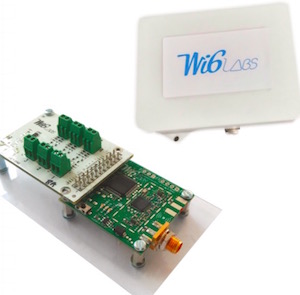Wi6Labs is a French company located in Rennes that specializes in private network solutions in isolated areas. Their technologies primarily use two open standards, 6LoWPAN (IPv6 over Low power Wireless Personal Area Networks) and LoRaWAN (Long Range Wide Area Network), and the SIGFOX standard. Wi6Labs’ focus is mainly in smart cities and smart agriculture, which means their engineers must offer reliable, secure, and low-power connections, which explains why they are heavily relying on STM32L microcontrollers (MCUs) and SPIRIT RF transceivers.
STM32L and SPIRIT for Low-Power Systems
 The STM32L series uses a Cortex-M3 architecture and ST’s proprietary ultra-low leakage processes to offer a standby power mode that consumes only 280 nA, and a run-mode current of only 9 µA. Furthermore, the MCU integrates an autonomous dynamic voltage scaling that quickly adjusts the power consumption based on the workload, so the overall power draw remains as small as possible throughout the different operations processed by the compute units. Some members of the STM32L family also offer hardware encryption, which means that encrypted communications are much more efficiently processed than if the system had to rely entirely on software cryptography.
The STM32L series uses a Cortex-M3 architecture and ST’s proprietary ultra-low leakage processes to offer a standby power mode that consumes only 280 nA, and a run-mode current of only 9 µA. Furthermore, the MCU integrates an autonomous dynamic voltage scaling that quickly adjusts the power consumption based on the workload, so the overall power draw remains as small as possible throughout the different operations processed by the compute units. Some members of the STM32L family also offer hardware encryption, which means that encrypted communications are much more efficiently processed than if the system had to rely entirely on software cryptography.
The SPIRIT RF transceiver consumes only 9 mA when receiving a signal and 21 mA when transmitting. This ultra-low-energy device is made possible thanks to ST’s integrated power management system that takes the form of a power supply regulator that draws energy from the battery and converts it with more than 80 % efficiency. Furthermore, when SPIRIT is shutdown, it doesn’t draw any current, extending battery life.
STM32 Open Development Environment for Fast and Flexible Development
 It is easy to understand why a company like Wi6Labs that focuses on low-power network solutions would rely on STMicroelectronics’ very efficient components, but this is only one side of the coin. As their engineers explain:
It is easy to understand why a company like Wi6Labs that focuses on low-power network solutions would rely on STMicroelectronics’ very efficient components, but this is only one side of the coin. As their engineers explain:
We enjoy developing using STM32 Nucleo controller and X-Nucleo expansion boards. It’s the fastest way to prototype a product with an architecture matching the final product, and since most of STM32L MCUs are pin-to-pin compatible, the hardware design can be easily adapted to match application requirements.
STM32 Nucleo development boards greatly simplify the conversion of concepts into product implementation thanks in part to the ability to easily benefit from numerous X-Nucleo expansion boards to build, test and optimize the performance and functionality of a platform. Users of the STM32 Nucleo boards also have access to libraries, source code, compilers, SDKs and a community that facilitates application building.
Wi6Labs is also part of ST’s Innovation Booster Initiative, which started in 2013 to allow ST to get closer to startups and provide them with support and guidance as they use ST’s solutions to their fullest potential. This blend of low-power, high efficiency components as well as a comprehensive set of flexible development tools, has allowed Wi6Labs to make their first 6LoWPAN sub–1 GHz mesh network. They were then able to quickly adapt using Janus data modem modules, to offer some of the best 6LoWPAN solutions the market has seen that ST was proud to showcase at Embedded World 2016 in Nuremberg, Germany.
To learn more about the groundbreaking work that goes on at Wi6Labs, you can visit their website. You can also find out more about the STM32L MCUs, SPIRIT RF transceivers, and STM32 Nucleo boards at STMicroelectronics’ website and documentation.




